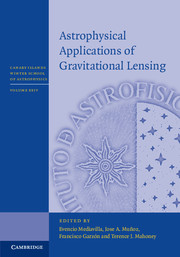Book contents
- Frontmatter
- Contents
- List of contributors
- List of participants
- Preface
- Acknowledgements
- 1 Lensing basics
- 2 Exoplanet microlensing
- 3 Four case studies of microlensing
- 4 Gravitational (micro)lensing of quasars and AGN
- 5 Dark matter in clusters and large-scale structure
- 6 The future of strong lensing
- 7 Methods for strong lens modelling
- 8 Tutorial on inverse ray shooting
- References
6 - The future of strong lensing
Published online by Cambridge University Press: 05 September 2016
- Frontmatter
- Contents
- List of contributors
- List of participants
- Preface
- Acknowledgements
- 1 Lensing basics
- 2 Exoplanet microlensing
- 3 Four case studies of microlensing
- 4 Gravitational (micro)lensing of quasars and AGN
- 5 Dark matter in clusters and large-scale structure
- 6 The future of strong lensing
- 7 Methods for strong lens modelling
- 8 Tutorial on inverse ray shooting
- References
Summary
We are on the verge of an explosion in data volume owing to recently started or upcoming surveys of the skies. One of the benefits of these new programmes will be the vastly increased number of known strong gravitational lens systems. In this chapter I will discuss three main topics: lens discovery in these surveys; the use of lensing to determine the mass distribution in galaxies, and in particular substructure in massive galaxy haloes; and cosmological measurements with large lens samples.
Introductory remarks
The next few decades will present an especially exciting time for strong gravitational lensing. This is because a combination of new instrumentation and, in some cases, brand new telescopes have come online, or are at an advanced stage of planning. With the enhanced observing capability enabled by these new facilities, a number of large-scale astronomical surveys are planned. These surveys will provide unprecedented combinations of depth, area, angular resolution and, in some cases, will open up poorly explored wavelength regimes. As a result, they should lead to orders of magnitude increases in the number of known strong lens systems. Indeed, although dedicated observational surveys for lenses have proved productive in the past, it is likely that the vast majority of future lenses will be discovered by mining the data produced by the new large surveys. The resulting large samples of lenses will lead to two major advantages: (1) improved statistics for investigations of galaxy properties, evolution in these properties and cosmology etc., and (2) the discovery of rare lens systems that are especially interesting and useful. As a complement to the large surveys, the planned construction of significantly larger ground- and space-based telescopes will provide enhanced follow-up capabilities of the new discoveries. Furthermore, advances in modelling and analysis codes will allow researchers to exploit more of the information available in observations of lens systems.
As is obvious at this point, this chapter has a focus on the field of strong gravitational lensing, and how it can be affected by large recently started and upcoming astronomical surveys. Taking this approach necessarily ignores other aspects of lensing that also have an exciting future. The new surveys will have a strong impact on investigations that utilize weak lensing or microlensing.
- Type
- Chapter
- Information
- Astrophysical Applications of Gravitational Lensing , pp. 183 - 212Publisher: Cambridge University PressPrint publication year: 2016



